Dark Chocolate: The Best and Worst Brands
Dark chocolate is arguably one of the best feel-good snacks for healthy eaters.
Research points to an increased exercise capacity and improved cardiovascular system.
This is due to the flavanol content – a type of polyphenol in cocoa that helps lower blood pressure, improve vascular function, and even provides UV protection for our skin.
What is a high quality dark chocolate?
When choosing a quality healthy dark chocolate, here are the qualities to look for in a bar.
- High cacao content (> 70%).
- Low sugar content.
- Few additives and overall ingredients.
- No added flavor.
- No preservatives.
- Not “dutched” or processed with alkali.
If your chocolate says “processed with alkali” on the nutrition label, then it will have fewer flavanols.
Processing with alkali is called Dutching, and it’s done to reduce acidity, making the chocolate a darker color (and arguably improving the flavor).
There is nothing unsafe about dutching – it may make the flavor more appealing to some, but lead to less health benefits.
Beware of marketing labels
Many chocolates are labeled with marketing words like artisan, hand-crafted, fine chocolate.
These are opinions and cannot be tested. Some chocolates are labeled gluten-free – which is odd as chocolate never contained gluten.
The best dark chocolate brands
My top 5 at a glance:
- Pascha is the best all round.
- Hu is a great choice if you can’t handle more than 70% 😉.
- The Taza 85% Mexicana Chocolate disk is special: Just cacao beans & sugar 😋
- Alter Eco 85% Raspberry Blackout – Dark with a tang of flavor.
- Lindt 85% is the best combo of value-for-money and healthy benefits.
Here’s the whole list, sort-of in order from best:
Pascha
Range of 55% – 100% cacao.
- Organic, fair trade, non-GMO
- No soy lecithin
- Is not dutch processed
Hu Dark Chocolate
A range of 70% cacao products including bars, chocolate-covered nuts, and chocolate-covered berries.
- Organic, vegan, paleo, non-GMO.
- No dairy, soy lecithin, gluten, cane sugar, sugar alcohols, or emulsifiers.
- Is not dutch processed.
Taza
70%, 80%, 87%, and 95% cacao bars.
Taza is among the least-processed chocolate you can find.
- USDA organic
- Is not dutch processed.
Alter Eco
USDA Organic and Fair Trade. No soy lecithin. Is not dutch processed.
The darks range from 70%, 85%, 90%, and the 100% total blackout.
- USDA Organic and Fair Trade.
- No soy lecithin.
- Is not dutch processed.
Lindt
The Lindt Excellence range includes 70%, 78%, 85%, 90%, 95%, 99%, and 100% Cacao bars.
Ingredients: Check your label as these change:
- 70% – Chocolate, sugar, cocoa butter, soya lecithin (emulsifier), bourbon vanilla beans.
- 78% – Chocolate, cocoa butter, sugar, cocoa powder processed with alkali, milkfat.
- 85% – Chocolate, cocoa powder, cocoa butter, demerara sugar, bourbon vanilla beans.
- 90% – Chocolate, cocoa butter, cocoa powder processed with alkali, sugar, bourbon vanilla beans.
- 95% – Chocolate, cocoa butter, cocoa powder processed with alkali, sugar
- 100% – Chocolate, cocoa powder processed with alkali, cocoa butter.
Beyond Good
70%, 73%, 80%, and 92% bars made at source in Madagascar.
- Completely organic
- Direct trade
- Is not dutch processed
Lok
70%, 85%, 100%.
- Bean-to-bar single-origin bars.
- Is not dutch processed.
Pacari
70%, 85%, 100%, 100% + nibs.
- USDA organic, direct trade, raw bars.
- Is not dutch processed.
Green & Blacks
USDA organic and fair trade.
70% and 85% dark.
Endangered Species
72%, 75%, and 88% bars.
- Fair trade.
- Donates 10% of profits to conservation efforts.
Theo
85% and many different flavored 70% bars.
- Fair trade and organic.
- No emulsifier
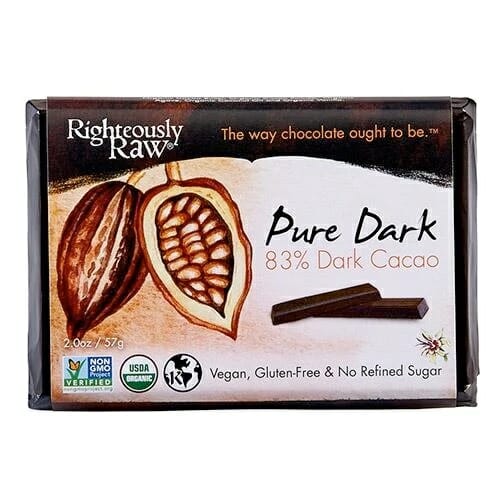
Righteously Raw
80%, 83%, and 90%.
- Organic, fair trade, raw.
As far as we’re aware only chocolate is processed on their machinery, so is allergen-free.
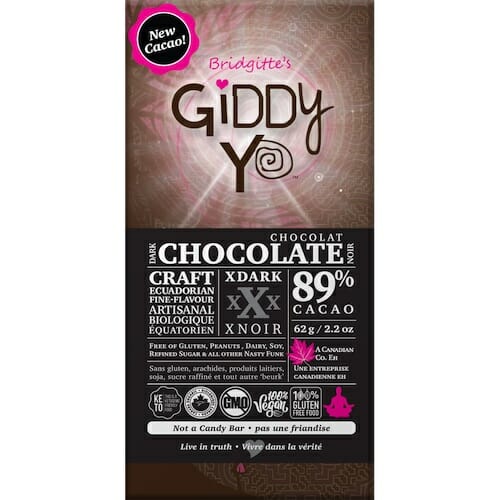
Giddy Yoyo
Huge range: 70% up to 100% (and almost everything in between). Based in Canada with simple ingredients (cacao paste + sugar + cacao butter).
- Certified organic
- Is not dutch processed
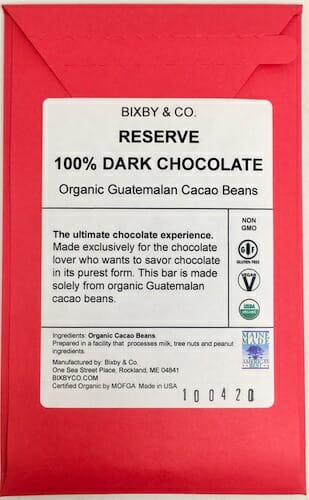
Bixby & Co.
70% and 100% single origin darks. Ingredients just cocoa beans and cane sugar.
- Certified organic
Valrhona
70%, 75%, 85%, and 100% cacao bars. French chocolatier with a large range of ‘taster’ bars.
Ingredients: Cocoa Beans, Sugar, Cocoa Butter, sunflower lecithin, Natural Vanilla Extract
Some product at Amazon.
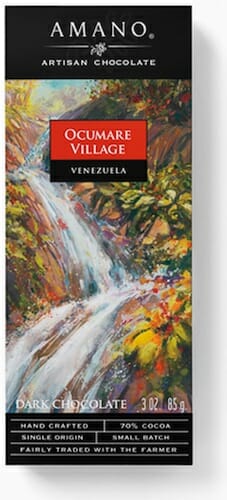
Amano
70% bars, single origin.
Sweetened with sugar and vanilla beans (no soy lecithin).
Moser Roth
70% and 85% bars. A German-made chocolate supplying Aldi stores.
Uses Soy Lecithin emulsifier.
85% is dutch processed.
Note that ingredients differ between countries.
Scharffen Berger
70% and 82% bars. (Scharffen is owned by a subsidiary of Hershey).
Ingredients: Chocolate, Sugar, Whole Vanilla Beans.
Lily’s
70%, 85%, and 92% – sweetened with Stevia (and Erythritol).
- Fair trade
- Is not dutch processed
Chocolove
Small producer with 70% and 88% bars. Does contain soy lecithin.
Ghirardelli
70%, 72%, 86%, 92% and a 100% “baking” bar.
Uses soy lecithin as an emulsifier, and also has milk fat and “natural flavor” in their dark bars.

ChocZero
Chocolate squares for keto diet market. Monk Fruit extract is used as a sweetener, and fiber has been added (soluble corn fiber).
The 85% or 92% are best.
Notable Mentions
There are many chocolate brands with a local market, some of whom offer exceptionally good chocolates.
Here is a curated collection of some that we’ve come across.
- Solomon’s Gold (New Zealand) – 70% bars and a 75% with cacao nibs. The nibs give it a unique texture and mouthfeel.
- Whittaker’s (New Zealand) – A huge variety of flavors – 72% Dark Ghana being a popular choice. The specialty blocks range from 70% to 92%.
- Loving Earth (Australia) – A great 72% and 85% bar – organic, and with some nice flavors.
- Camino (Canada) – The ‘Intensely Dark’ 88% is the best choice.
- Valore (Spain) – Have a 70% bar with very high almond content (25%).
- Ombar (UK) – Raw chocolatiers with 72%-100% dark.
- Guittard (CA) – 80%-91% dark chocolate.
- Antidote (USA) – Does 100% raw chocolate bars.
- Eden Confections (US Northeast) – 70% – no sugar (sweetened with Monk fruit and erythritol.
- Eating Evolved (NY) – Organic right up to 100%.
- Zotter Chocolates (Austria) – they offer a mouthwatering array of flavors, and also, 80%-96% dark chocolate bars (the Labooko range) – also certified Fair Trade.
- Heidi (Romania) – Do a 70%, 75% and 85% bar. Similar formulation to Lindt.
- Montezuma Chocolates (UK) – The biggest range of 100% bars you’ll find.
- Vannucci Chocolate (Italy) – 73% and 100% bar.
- Moonstruck Chocolate (USA) – Specialty chocolates – 68% and 73% dark.
- Askinosie (USA) – Single origin – try the super dark 88%.
- Zazubean (Canada) – Fair trade and organic. Includes an 85% bar – for the keto market.
- Frey (Switzerland) – Look for the 85% bar.
- Claudio Corallo – Artisan chocolate made from the most simple ingredients.
- Vosges (USA) – Lots of interesting flavors including the 85% cacao fruit bar.
- HNINA (USA) – raw organic dark chocolate – 85%. No sugar, soy, or dairy.
- Cocoa Parlor (USA) – USDA organic and fair-trade, 70% up to 100%. The subtitle is “organic plant-based chocolates”. Well, I guess cacao does come from a tree !?
- Vanini (Italy) – Range from 70%-100% single origin.
- Pana Organic (UK) – Selection of raw organic bars, including ‘Eighty’ – sweetened with dark agave nectar.
- Sam’s Choice (Walmart) – Choose the 90% dark. Ingredients: Chocolate liquor, cocoa butter, sugar, cocoa powder, vanilla beans.
- Ritter Sport (Germany) – Mostly milk chocolates, but they do have a 74% and 81% dark bar.
- The Good Chocolate – A selection of chocolates for Keto dieters (sweetened with Stevia and erythritol).
Bean to Bar: Soleil Chocolate
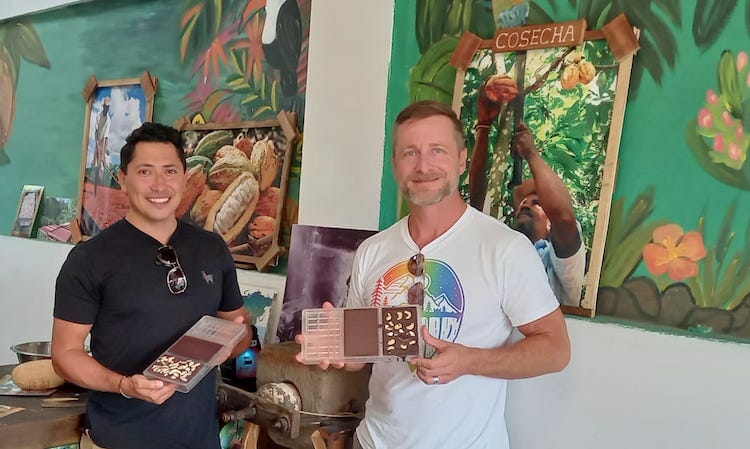
Posing with the bars we made
I recently traveled to Costa Rica and participated in a chocolate tour at Soleil.
The tour involved learning about cacao and trying whole raw cacao beans. We learned how to make bean to bar chocolate by removing the outer shell, and then grinding the cacao nibs to release the oils.
We then tempered the processed cacao and sugar and put the chocolate into molds.
The taste was amazing and some of the best dark chocolate I’ve ever had.
If you ever go to Costa Rica I recommend paying them a visit at their facility just outside San Jose in Atenas, Costa Rica.
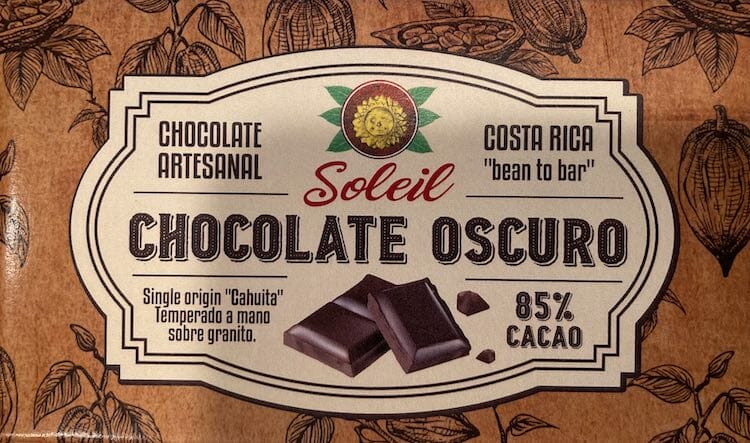
Strongest dark chocolate bars
The more cacao the bar has, the stronger the bar is.
10 years ago, it was hard to find many bars above 70%, but now there is a great choice. If you have a sweet tooth, it will take some practice to go beyond 70%.
Is there such thing as 100% dark chocolate?
Yes. It means there is no form of sweetener at all, giving the chocolate a bitter savory flavor.
Generally, dark chocolates above 90% have very little sweetness and are an acquired taste.
The following brands make very dark chocolates (including 100%).
- Pascha 100%
- Alter Eco 90% and 100%
- Taza 95% Wicked Dark
- Lindt 95%, 99%, and 100%
- Pacari 100% and 100% + nibs
- Vivani 92% and 100%
- Giddy Yoyo Raw 100% Cacao
Dark chocolates that aren’t very healthy 👎
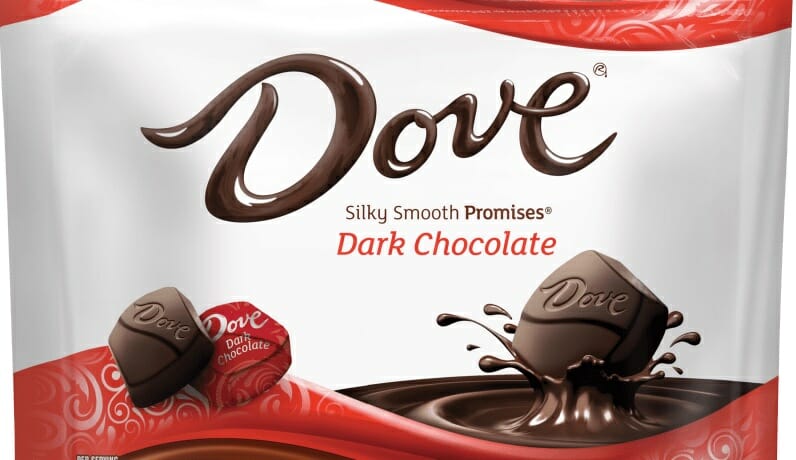
A popular bar, but Dove dark chocolates don’t make the grade.
There is no legal definition of dark chocolate. Most people consider anything above 55% cacao content to be dark.
That doesn’t stop candy manufacturers calling their product dark, when the cacao content is very low.
- Dove Dark Chocolate
Low cacao content. All processed with alkali. - Godiva 72% dark mini bars
Lots of packaging, uses Soy lecithin, and butter oil. - CocoaVia Supplement Packs
These are similar to Crystal Light, except they have flavanols added in. You will get some health benefits from this, but it is more important to eat the whole food that contains the fiber. - Hershey’s Special Dark
Processed with alkali. High in sugar. - Hershey’s Dark Chocolate Kisses
Despite claims on the package about flavanols, this is a milk chocolate. - Dark Chocolate M&M’s
The ingredients list is ambiguous (they list “chocolate” as an ingredient). However, these are high in sugar (more like candy than dark chocolate).
- Milky Way Midnight
Like all the candy brands, this is not really a dark chocolate. It has more sugar than cacao and is processed with alkali.
- Kit Kat Dark
Not sure how they can call this dark. Lots of sugar and palm kernel oil. - Nestle Dark Hot Chocolate
Ouch! This beverage mix is the worst of the lot. Sugar, trans-fat, and processed with alkali. - Cadbury Bournville
60g of sugar per small bar. - Cadbury Old Gold
It says dark chocolate on the label, but it is a dairy milk – with a high sugar content. - Cadbury Royal Dark
Ingredients: Semi-Sweet Chocolate (Sugar; Cocoa Butter; Chocolate; Milk Fat; Natural and Artificial Flavor, Soy Lecithin; Milk). Again – a milk chocolate. - Brookside Dark Chocolate. This Hershey’s brand is a milk chocolate. Originally marketed as ‘containing fruit’, they have now changed their wording to fruit ‘flavors’.
- Choceur
This brand is exclusive to Aldi stores. However the ‘dark’ is only 45% cocoa and is really a milk chocolate. Aldi was also forced to recall the chocolates in 2017 due to almond pieces ended up in some bars.
What is a high quality dark chocolate?
Dark chocolate can be a tasty treat when tracking macros but not all could be considered healthy.
A true dark chocolate will never have sugar listed first in the ingredients. It should always be below the cocoa ingredients.
It should also tick as many of the following points:
- 100% Organic
Note that “organic” does not equal 100% organic (confusing!). - Fair Trade
- > 80% cocoa
- Not processed with alkali
What’s the deal with Soy Lecithin?
Also, note that some manufacturers use GMO (genetically modified) ingredients (this is usually the soy lecithin).
Soy lecithin is a byproduct of processed soybeans and is used as an emulsifier (prevents water and fat from separating).
It is considered safe, although some people object to the solvent that’s used to extract the lecithin.
Many chocolate manufacturers have moved on to other emulsifiers (such as sunflower lecithin).
Most dark chocolates are produced on the same processing line as chocolate products containing milk. Which is why most of them have advisory labels. A 2017 testing of 88 bars concluded that “a high proportion of dark chocolate products contain milk at concentrations associated with allergic reactions in sensitive individuals”.
The good news is that all bars labeled as peanut-free were peanut-free. However, 17% of chocolates that had no labeling about nuts DID contain traces of peanuts.
Dark chocolate, like many foods including meat, grains, fish, and vegetables has traces of heavy metals. This has nothing to do with manufacturing, but the presence of these metals in soils where cacao is grown. The EU has limits on the amounts of cadmium – 0.8 mg/kg for dark chocolate. California is stricter: 0.45 mg/kg for 65%-95% chocolate. In CA if the chocolate has more than this – it must be labelled with a health risk warning. Given the small volumes of dark chocolate that we eat, cadmium in chocolate should not be viewed as a major concern.
More of the best and worst:
- Almond Milk Brands
- Plant-Based (Meatless) Burger Brands
- Coconut Milk Brands
- Rice Milk Brands
- Snack Bar Brands
- Kombucha Brands
Sources
- Vlachopoulos, C., Aznaouridis, K., Alexopoulos, N., Economou, E., Andreadou, I., & Stefanadis, C. (2005). Effect of dark chocolate on arterial function in healthy individuals. American journal of hypertension, 18(6), 785-791.
- Grassi, D., Desideri, G., Necozione, S., Lippi, C., Casale, R., Properzi, G., ... & Ferri, C. (2008). Blood pressure is reduced and insulin sensitivity increased in glucose-intolerant, hypertensive subjects after 15 days of consuming high-polyphenol dark chocolate. The Journal of nutrition, 138(9), 1671-1676.
- Sansone, R., Rodriguez-Mateos, A., Heuel, J., Falk, D., Schuler, D., Wagstaff, R., ... & Flaviola Consortium. (2015). Cocoa flavanol intake improves endothelial function and Framingham Risk Score in healthy men and women: a randomised, controlled, double-masked trial: the Flaviola Health Study. British Journal of Nutrition, 114(8), 1246-1255.
- Williams, S., Tamburic, S., & Lally, C. (2009). Eating chocolate can significantly protect the skin from UV light. Journal of cosmetic dermatology, 8(3), 169-173.
908 Comments





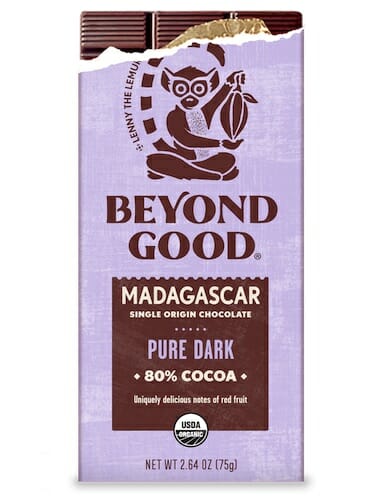














 How to create macro meal plans (quickly) using ChatGPT
How to create macro meal plans (quickly) using ChatGPT Calorie Deficit Meal Planner
Calorie Deficit Meal Planner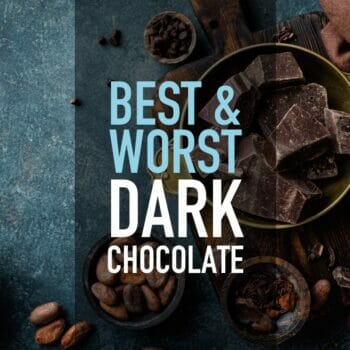 Dark Chocolate: The Best and Worst Brands
Dark Chocolate: The Best and Worst Brands Macro Friendly Family Dinners
Macro Friendly Family Dinners The Best Plant-Based Burgers: Brands to Choose and Avoid
The Best Plant-Based Burgers: Brands to Choose and Avoid
I can eat 100% cacao squares, but need stevia to process the taste. I get a small cup and put stevia grains in it the I dip a corner of the bar in it so it is coated and nibble of that piece. Very nice taste and I just keep dipping and nibbling. 100 % cacao = 0 calories. Stevia also is 0 calories. Its a win-win and both are natural and organic.
Hey James,
What’s the chance of you adding our 72% dark chocolate to your listing?
https://www.bouchardchocolate.com/ourchocolates
Bouchard Chocolate
Is it fair trade?
GBs 85% says Cocoa in the ingredients, not cacao…
http://us.greenandblacks.com/organic-85-dark-cacao-bar.html
Perhaps they don’t even know the difference?
Yeah, almost all of these are low grade and don’t contain cacao in the percentages that they list, but instead, contain cocoa. Difference is, cocoa is heated to 130 degrees and burns off the health benefits of the cacau. Cocoa is not cacao. There are only a few brands that list the percentage and actually provide cacao in the ingredients instead of cocoa, but I don’t believe there are ANY on this list.
Pacari is on the list and is a raw chocolate and lists the actual percentage of cacao
Indeed, they do appear authentic, as I stated though, “almost all”. 🙂
Hi there! I just purchased some Moser Roth chocolate today, both 70% and 85%, and noticed in the list of ingredients that the cocoa in the 85% bar is processed with alkali. Just an FYI in case you want to update that in your list!
Thanks for the heads up. We’ll update the list.
I’m surprised none of the Trader Joes dark chocolate bars aren’t rated here, they actually do have a great variety, some are even organic and fairly low in sugar.
I agree. I’m a dedicated consumer
of Valrhona 85%.
Hi! the amount of the cacao isn’t what’s important (needs to be 70+%, though). What matters most is that it is raw, unprocessed (not alkalized, Dutched, or roasted). The chocolates you mention are not raw. Therefore, you lose over 80% of the health benefits. It’s still candy, even if the sugar content is small.
There are some raw brands mentioned, In fact, I just added Pacari a couple days ago. Do you have scientific evidence that the antioxidant value of cacao is nullified by heating?
Yes. Harvard discovered the Epicatechin antioxidant and has stated that it is the first one to be destroyed with heat (even at 117 degrees!) which is the temperature max for a food to be considered raw. A really good company will not heat over 110 degrees in order to preserve this amazing new discovery from Harvard (Dr. Hollenberg, who did the long study on the Kuna Indians).
Just think of how cooking our veggies destroys their health benefits. Same with chocolate.
When you read the chocolate studies from the major research facilities, there are 4 common elements: cacao is raw (not heated over 117 degrees), unprocessed, minimum 70% cacao and 600-900 mg flavanols daily.
Their amazing findings (mood, cholesterol, brain, heart, circulation, blood pressure, oral health, inflammation, etc.) are based on these elements.
To my knowledge, there is only one company in the US that meets all these standards and is 3rd party verified for it’s ORAC and Flavanoid count on each piece. They also obtained the TM from the US and Japanese governments after almost 8 years of verification of this scientific data.
So, even though there are some companies now making chocolate products better than the “candy”, I’m consuming the ones that are Non GMO and certified (each piece) with the antioxidant information that are beneficial to my health.
Hope this helps! And, thanks for all your good information. People out there want, and need it!
https://www.scientificamerican.com/article/raw-veggies-are-healthier/
Hellooo? Try looking into the whole picture?[regarding the veggies comment]
Which brand IS the best health-wise that’s manufactured in the US???
Rainbow butterfly, so which companies are they you know meets all of these standards if you don’t mind sharing? Thank you!!
It is impossible to honestly make a raw chocolate. Cocoa pulp and seed are fermented at the grower (usually) and that fermentation takes it above the temperature of a “raw” food. That fermentation is almost always conducted in a tropical environment which will produce temperatures well above raw. Without fermentation, cocoa will not taste of chocolate. It is the fermentation that brings the flavor to the otherwise nearly inedible seeds!
There is no way around the fermentation.
ANY chocolate label that claims to produce raw chocolate is ignoring the temperatures in the fermentation process.
COCOFUEL! Organic, Fair Trade, sweetened with less than a teaspoon of honey, 6-10g per bar, no soy lecithin and 3 flavors are completely dairy and sodium free! And the taste is delicious. Kids are big fans.
Hi! Interesting exchange of comments. It appears that many of you are looking for the health benefits that are found in raw, dark chocolate. We read and hear about new studies coming out every day talking about the amazing benefits derived from the antioxidants found in cacao.
Here are the most important facts. The baseline for these studies is: (1) minimum 70% raw cacao, and (2) 600-900 mg of Flavanoids per day. Until recently, we, the consumer didn’t have access to this raw, unprocessed chocolate that they used in their clinical studies.
You might be purchasing 100% cacao, but it’s still candy. If commercially made, it has been roasted (at high temperatures), alkalized, Dutched, etc. This destroys over 80% of the health benefits.
Epicatechins, an antioxidant discovered by Harvard Medical School just ill the past few years is found in cacao. It is the most potent antioxidant, and the first to be destroyed with heat. Dr. Hollenberg (Harvard Medical School) stated that
“The health benefits of epicatechin, a compound found in cocoa, are so striking that it may rival penicillin and anaesthesia in terms of importance to public health” and that “epicatechin is so important that it should be considered a vitamin”.
Therefore, what is really important to look for in your chocolate is that it is raw, unprocessed, caffeine free, gluten free, Non GMO, beneficial for diabetics (no processed sugars), and has a certification of it’s Flavanoid and Antioxidant content.
To date, the US Government (after almost 8 years of checking the product and science behind it) has only given the “Healthy Chocolate” trademark to one company. And, I just found out they have received it from Japan, as well.
Price? Half of what you would pay for Godiva and many other “name brand” candies.
However, you won’t find this in your big retailers sitting next to their “candy”. You will only find it in Mom & Pop health food stores, from health care professionals, at health fairs, or direct from the company (which I do to save paying the retail markup from the retailers).
i actually read about this chocolate on the website (and called them with questions):
PrimeChocolate4You.com
They have a wonderful Customer program. I purchase product every month and they let me choose free product every 3rd month as their way of saying “thank you” and taking care of their customers. Doesn’t get much better or healthier than this!
How true is this?
Amazing, i am finding myself eating 99 and 100 percent. Everyday. Great smooth taste.
lindt 99% is my favourite. it is available in almost every supermarket in germany.
According to Lindt’s website, the 99% cocoa chocolate bars are also processed with alkali.